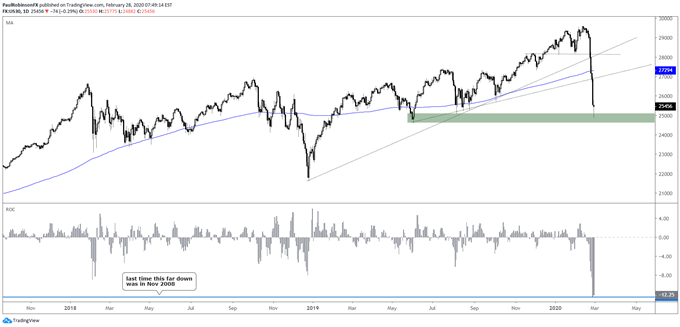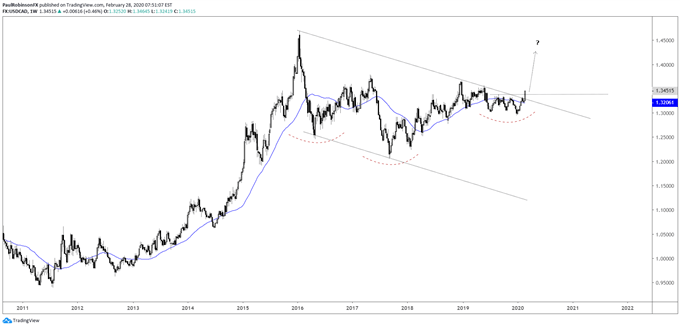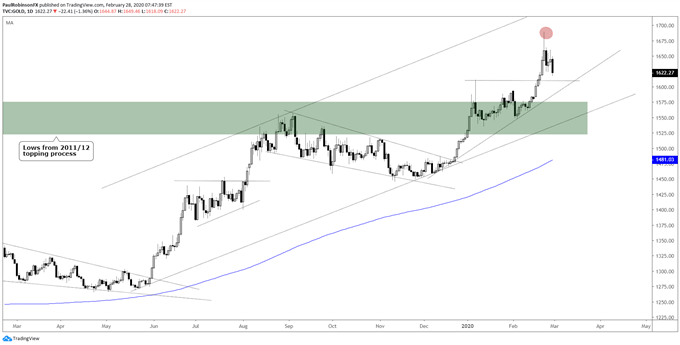How to Use the Weekly Time Frame in Forex Trading - DailyForex.com
How to Use the Weekly Time Frame in Forex Trading - DailyForex.com |
| How to Use the Weekly Time Frame in Forex Trading - DailyForex.com Posted: 28 Feb 2020 02:11 AM PST One of the main reasons why most Forex traders lose money is a failure to trade based upon longer-term, higher time frames such as the weekly time frame. This article explains why and how to use the weekly time frame in your Forex trading, and outlines both rules and actual historical performances of a few weekly time frame trading strategies which you might use or adapt. What is Time Frame in Forex Trading?"Time frame" in Forex trading means the unit of time that the price chart you are viewing is based on. For example, in a weekly time frame Japanese candlestick chart, each candlestick represents one week of time. In a 5-minute time frame Japanese candlestick chart, each candlestick represents 5 minutes of time. Shorter time frames show much more detail of price movement over time, but longer time frames show wider, longer-term pictures of trends and ranges in the price. Why You Should Use the Weekly Time Frame in Forex TradingThe most effective, profitable, and powerful tool you can use to trade Forex is to pay attention to whether or not there is a long-term trend or range in any currency pairs or crosses, especially the major pairs; and if so, in which direction that trend is going. Then, make sure that you trade in the same direction as that trend, or trade reversals from support and resistance when there is no trend and the price is ranging. Use a higher time frame price chart such as the weekly time frame to make these calls. While you can use a daily time frame chart for the same purpose, you should use the weekly time frame in Forex trading for this because it is easier to judge the very long-term price action at a glance there. It is also a good idea to drill down and use at least one shorter time frame chart as well, such as the 4 hour or hourly time frames, to fine-tune your trade entries and exits to make them more precise, which also means more profitable. How to Measure Trend with the Weekly Time FrameThe reason why the weekly time frame is the best time frame for trading Forex is because historical Forex data shows that when the price is higher than it was several months ago, it is more likely to rise than fall, and vice versa when the price is lower than it was several months ago. So, if you pull up a weekly chart, one easy trick you can do to create the best trend indicator, is count back 13 and 26 weeks from the current weekly candlestick. Is the price now higher than it was at those times? If yes, you have a long-term uptrend. If it was lower at both, you have a long-term downtrend. If the results are mixed, you have no trend. Forget all the fancy Forex indicators – this is a method which is both very simple and effective. For example, the weekly timeframe chart of the EUR/USD currency pair below shows the current weekly candlestick, on the far right, clearly below the opening prices of the candlesticks from 13 and 26 weeks ago. So, there is a clear downtrend, and this week traders can look for short trades in this currency pair. Weekly Time Frame: Long-term Downtrend In another example, the weekly timeframe chart of the GBP/USD currency pair below shows the current weekly candlestick, on the far right, closing above the opening price of the candlestick from 13 weeks ago, but also below the opening price of the candlestick from 26 weeks ago. So, there is no long-term trend, and next week traders who want to trade this currency pair should look to trade reversals at support and resistance levels. Weekly Time Frame: No Long-term Trend Should You Use Only One Time Frame in Forex Trading?Although a weekly time frame chart can show you a trading edge, in all except very limited circumstances (explained in more detail below in the "Trading Forex with the Weekly Time Frame Only" section), it is not smart to trade using the weekly time frame alone. In fact, using just a single time frame to trade Forex is usually a bad idea, whatever time frame you might pick. However, using higher time frames such as the weekly price chart, can at least tell you whether there is a long-term trend and if so, in what direction. There are several reasons why trading using the weekly time frame alone is usually a bad idea:
Multi Time Frame Trading with the Weekly Time FrameMultiple time frame analysis is simply looking at two or more price charts for the same Forex currency pair or cross or other instrument, at the same time. You make a multiple time frame analysis by looking first at a higher time frame and using that chart to determine whether the price is trending (and if so, in what direction) or ranging, and also maybe to identify clear support and resistance levels. It is a top-down analysis, because once you have that information from the higher time frame, you then use a lower time frame to trade from that analysis, which will usually get you more precise trade entries and exits which should maximize your reward to risk ratio. There are a few good Forex trading strategies which have historically been profitable on the weekly time frame, outlined below. You can use a shorter time frame as a tool to trade these strategies more effectively. The results detailed below are from back tests conducted on sixteen major and minor Forex currency pairs over a very long period of almost 20 years, from 2001 to 2020. Thousands of samples were taken, increasing the statistical validity of the back test. Weekly Multi Time Frame Breakout Trend Strategy
Weekly Breakout Trend Strategy: Short Trade Entry Weekly Multi Time Frame "Buy the Dips" Trend Strategy
Weekly "Buy the Dips" Trend Strategy: Short Trade Entry There are also two weekly trading strategies with good track records which can more safely be used with only the weekly time frame. Trading with the Weekly Time Frame OnlyThese strategies produce trades which are meant to be entered just as a week ends, and held until the same time next week, without a stop loss. This can of course be traded more precisely by using a shorter time frame as well. Weekly Time Frame "Buy the Strong Dips" Trend Strategy
Weekly "Buy the Strong Dips" Trend Strategy: Long Trade Entry A back-test equity curve of this strategy using weekly moves from open to close greater than 2% in value trading 16 Forex currency pairs and crosses from 2001 to 2020 is shown below. Trades were hypothetically entered at the end of a qualifying week and held until the next week's close. Spreads and overnight financing payments/charges were not included. Weekly "Buy the Strong Dips" Trend Strategy: Equity Curve Weekly Time Frame "High Volatility Mean Reversion" Strategy
Final Thoughts
|
| Dow Jones, USD/CAD, Gold & More: Charts for Next Week - DailyFX Posted: 28 Feb 2020 05:01 AM PST Charts of Interest:
Dow Jones is in historically oversold territory with only a handful of times in the last 40 years being so overdone when looking at the short-term. The Dow futures are off nearly 13% over the course of the last five sessions, a threshold not seen since the depths of the financial crisis. A bounce is due, and with growing chatter about possible emergency measures by central banks it could be a big one. We will take it one day at a time, but a bounce is seen as happening sooner rather than later.   Recommended by Paul Robinson Check out our equity market outlook. Dow Jones Daily Chart (historically oversold) Dow Jones Chart by TradingView USD/CAD is working on a significant breakout that could lead to some longer-term gains and a generally bullish trading bias on shorter-term charts. The pair is currently crossing over the 2016 trend-line and above some highs formed during the latter part of 2019. A weekly close (holding today's rally) above 13382 would be ideal as confirmation. USD/CAD Weekly Chart (working on sustaining a breakout) Gold is sharply underperforming expectations, catching many off guard. It looks as though a decline could deepen some more here, or a sideways move at best. Short-term this means sellers may have the upper hand, but the long-term picture is still bullish with the trend remaining firmly pointed higher. Keep an eye on the trend-line from December, and the area down in the mid-1500s, as this was the area gold struggled with from the 2011/12 topping process. Gold Daily Chart (watch support levels) For all the charts we looked at, check out the video above… Resources for Index & Commodity TradersWhether you are a new or an experienced trader, DailyFX has several resources available to help you; indicator for tracking trader sentiment, quarterly trading forecasts, analytical and educational webinars held daily, and trading guides to help you improve trading performance. We also have a series of guides for those looking to trade specific markets, such as the S&P 500, Dow, DAX, gold, silver, crude oil, and copper. ---Written by Paul Robinson, Market Analyst You can follow Paul on Twitter at @PaulRobinsonFX |
| You are subscribed to email updates from "forex charts" - Google News. To stop receiving these emails, you may unsubscribe now. | Email delivery powered by Google |
| Google, 1600 Amphitheatre Parkway, Mountain View, CA 94043, United States | |






Comments
Post a Comment